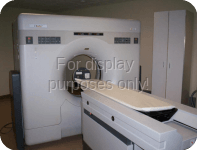The Picker Twin Flash is a computed tomography (CT) scanner developed by Picker International (later acquired by Philips Medical Systems). Known for its innovative design during its time, the Twin Flash was primarily used for advanced diagnostic imaging in a variety of clinical applications.
Key Features
Dual X-Ray Tubes:
The Twin Flash utilized a dual X-ray tube design, which allowed for faster scan times and higher-resolution images, particularly for dynamic studies like perfusion imaging or angiography.
High-Speed Imaging:
Designed to perform rapid scans, making it ideal for time-sensitive diagnostics such as trauma or stroke imaging.
Multislice Technology:
The system could capture multiple slices of data per rotation, improving image quality and reducing scan times.
Dynamic Range Imaging:
Enhanced dynamic range capabilities to improve visualization of subtle tissue differences, useful for diagnosing complex conditions.
Efficient Workflow:
Featured user-friendly interfaces and automation tools to streamline patient setup, scanning, and image processing.
Broad Clinical Applications:
Capable of performing a wide range of CT studies, including head, chest, abdomen, musculoskeletal, and cardiovascular imaging.
Clinical Applications:
- Neurology: Ideal for detecting strokes, brain injuries, and other neurological conditions.
- Cardiology: Used for imaging coronary arteries and assessing cardiac function.
- Oncology: Effective in detecting and monitoring tumors or metastases.
- Emergency Medicine: High-speed scans enabled quick diagnoses for trauma or critical care situations.
- Orthopedics: Suitable for detailed imaging of bones and joints.
Spec
CT Type: Picker Twin Flash CT
Year of Manufacture: 2000
Tube Type: Varian X-Ray Tube
Slices on the Tube: Dual Slice
Gantry count: 974,931
While revolutionary in its era, the Twin Flash has been surpassed by modern CT scanners that offer higher slice counts, lower radiation doses, and advanced imaging features such as dual-energy CT and AI-enhanced diagnostics.


